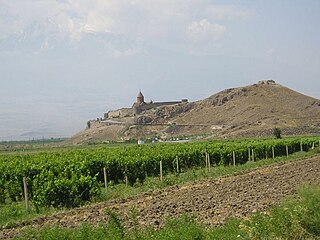
Brandy is a liquor produced by distilling wine. Brandy generally contains 35–60% alcohol by volume and is typically consumed as an after-dinner digestif. Some brandies are aged in wooden casks. Others are coloured with caramel colouring to imitate the effect of ageing, and some are produced using a combination of ageing and colouring. Varieties of wine brandy can be found across the winemaking world. Among the most renowned are Cognac and Armagnac from southwestern France.

Dessert wines, sometimes called pudding wines in the United Kingdom, are sweet wines typically served with dessert.
Schnapps or schnaps is a type of alcoholic beverage that may take several forms, including distilled fruit brandies, herbal liqueurs, infusions, and "flavored liqueurs" made by adding fruit syrups, spices, or artificial flavorings to neutral grain spirits.
Rakia, Rakija, Rachiu or Raki, is the collective term for fruit spirits popular in the Balkans. The alcohol content of rakia is normally 40% ABV, but home-produced rakia can be stronger.

Krems an der Donau is a town of 23,992 inhabitants in Austria, in the federal state of Lower Austria. It is the fifth-largest city of Lower Austria and is approximately 70 kilometres west of Vienna. Krems is a city with its own statute, and therefore it is both a municipality and a district.

Austrian cuisine is a style of cuisine native to Austria and composed of influences from Central Europe and throughout the former Austro-Hungarian Empire. Austrian cuisine is most often associated with Viennese cuisine, but there are significant regional variations.

Slivovitz is a fruit spirit made from damson plums, often referred to as plum spirit. Slivovitz is produced in Central, Eastern and Southern Europe, both commercially and privately. Primary producers include Serbia, Bulgaria, Czech Republic, Greece, Hungary, Italy, North Macedonia, Poland, Romania, Bosnia and Herzegovina, Slovakia, Slovenia, Croatia, and Ukraine. In the Balkans, slivovitz is considered a kind of rakia. In Central Europe it is considered a kind of pálinka, and similar to Romanian țuică, corresponding to the distilled spirits category. UNESCO put it in a UNESCO Intangible Cultural Heritage Lists in 2022 on request of the country of geographic origin Serbia.

Crème de Noyaux is an almond-flavored crème liqueur, although it is actually made from apricot kernels or the kernels of peach or cherry pits, which provide an almond-like flavor. Both Bols and Hiram Walker produce artificially colored red versions of the liqueur while Noyau de Poissy from France is available in both clear (blanc) and barrel-aged amber (ambre) versions.

Trockenbeerenauslese, or TBA, is a German language wine term for a medium to full body dessert wine.

Pálinka is a traditional fruit spirit with origins in Carpathian Mountains, more exactly known under several names, and invented in the Middle Ages. Protected as a geographical indication of the European Union, only fruit spirits mashed, distilled, matured and bottled in Hungary and similar apricot spirits from four provinces of Austria can be called "pálinka", while "Tótpálinka" refers to wheat-derived beverages. Törkölypálinka, a different product in the legal sense, is a similarly protected pomace spirit that is commonly included with pálinka. While pálinka may be made of any locally grown fruit, the most common ones are plums, apricots, apples, pears, and cherries.

Malva pudding is a sweet pudding of South African origin. It contains apricot jam and has a spongy caramelised texture. A cream sauce is always poured over it while it is hot, and it is usually served warm with custard and/or ice-cream. Many South African restaurants offer it. The pudding is thought to originally be of Dutch then Cape Dutch origin synonymous with the Cape.
Apricot brandy can refer to a liquor distilled from fermented apricot juice or a liqueur made from apricot flesh and kernels.
Armenian cuisine includes the foods and cooking techniques of the Armenian people and traditional Armenian foods and dishes. The cuisine reflects the history and geography where Armenians have lived as well as sharing outside influences from European and Levantine cuisines. The cuisine also reflects the traditional crops and animals grown and raised in Armenian-populated areas.

Marpha brandy is a type of fruit brandy produced in the Marpha village of Mustang district in Nepal. It is manufactured from a variety of local fruits such as pear, apricot, apple, etc. and is mostly made by the Thakali people—an ethnic group indigenous to Mustang region. Its strength is around 42% ABV.

Knedle, is a dish of boiled potato-dough dumplings filled with plums or apricots, originating in the Austro-Hungarian Empire. Popular in Central and Eastern European countries, the dish is eaten as dessert, a main dish, or side dish.
Fruit spirit is a distilled beverage produced from mash, juice, wine or residues of edible fruits. The term covers a broad class of spirits produced across the world, and typically excludes beverages made from grapes, which are referred to as plain brandy or pomace brandy. Apples, pears, apricots, plums and cherries are the most commonly used fruits.
Oghi is an Armenian spirit distilled from fruits or berries. It is widely produced as moonshine from home-grown garden fruits all across Armenia, where it is served as a popular welcome drink to guests and is routinely drunk during meals. Arguably, Armenian oghi is not "vodka" at all and merely became thought of as such during the Soviet era in Armenia.

Armenian wine is wine made in Armenia and the Armenian-populated Republic of Artsakh, in the region of South Caucasus. Armenia is one of the oldest wine producing regions of the world. In particular, the oldest known winery was found in Armenia's Areni region, which to this day is still known of its wine production and endemic grapes.

Marillenknödel is a pastry common in Austrian and Czech cuisine. Marillen is the Austro-Bavarian term for apricots and this pastry is found predominantly in areas where apricot orchards are common, such as the Wachau and Vinschgau regions.












